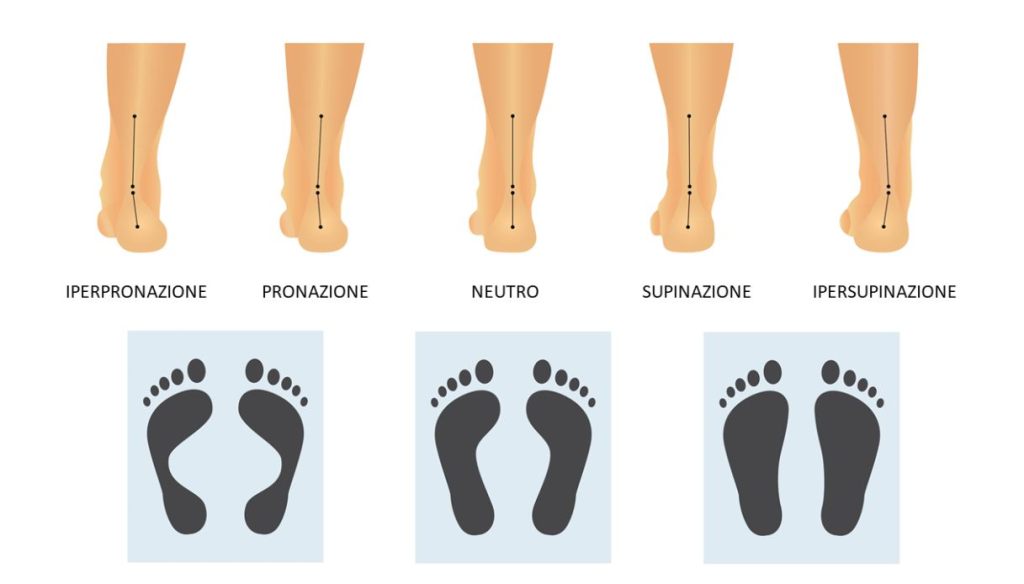Table of Contents
To each his own foot
The foot represents a beautiful mechanism, a set of bones, tendons and ligaments that help us to carry and unload all our weight. The point between the two feet represents the center of the docking station that is the area into which we unload all the weight. The column is made up of several curves and going down we meet the pelvis, which connects the upper and lower parts of the body. A foot that wears the wrong shoes or that unloads the weight badly is encountered joint problems in the upper joints, hammer toes, plantar fasciitis, tendinitis, pain in the ankles, heels and many other inflammatory forms.
In general they exist big differences between foot and foot given by the conformation, the experience, the sports practiced, the overall postural attitude. In general, we can say that:
- a normal foot needs neutral, cushioning shoes;
- if, on the other hand, a excess pronation [ndr. rotazione del piede verso l’interno], the footwear should give protection, safety;
- the flatfoot requires a shoe that allows you to control movements well;
- cushioning and neutral footwear are used for the hollow foot or with excess supination or the so-called clubfoot, which reports a deformity in which the axis of the foot forms an angle greater than the right angle with the axis of the leg, often giving problems also to the ankle.
If we see that many internal imbalances in the body are discharged in the foot, we also find the solution in the foot. Going to observe our stepBy modifying the structure in the static phase, massaging it, knowing its lines, we can improve the condition of the foot and therefore of the entire structure. The steps of the step are different and each step requires different actions of the foot and the rest of the body.
How weight is placed on the foot
We must think of the step as a cycle, a set of phases that we are now going to explore. When we talk about gait cycle we refer to the study of the kinematics and biomechanics of human locomotion concerning the path. The gait cycle is defined as the period between two successive supports of the same limb on the ground. It is a time window in which two different phases take place: stance phase, or support phase, during which the foot remains in contact with the ground. In normal walking it occupies about 60% of the cycle, while obviously with running it reaches 37% in sprinting.
In addition to the support we have the swing phase, or transfer phase where the limb goes all forward to prepare the ground for the next support. Within the stance phase we find five different moments while there are three in the swing phase. In the stance we find the initial contact, the response phase, the intermediate support, theterminal support and the moment before the swing. The swing phase includes the initial moment, the suspension and the initial moment which is then obviously followed by a new support.
Important tips for the support of the foot
To understand first of all if you have a flatfoot or a arched foot, just see the imprint it leaves. You can dip your foot in water and then place it on a cardboard to wet it or make it dark. If it were very arched, you could be supinating, while if on the cardboard it remains completely or almost all of the footprint of your sole means that your feet are those of an overpronator, i.e. flat, resulting in an excessive inward tilt of the foot while walking or running. In this last case we need a shoe that supports the arch and supports the foot. If the support is supinated, on the other hand, we must choose stable shoes, as the foot tilts outward when the foot rests on the ground during a walk or a run.

In any case it is necessary stimulate the foot even walking barefoot on a garden or lawn, massaging the entire arch, treating yourself to a foot reflexology treatment, being the foot full of reflex points connected to viscera and internal organs. Massaging the foot has enormous benefits on the nervous system as well.
Sometimes back pain also depends on the foot, whether it is descending (starting from the top) or ascending (starting from the bottom). In many cases this is an overload management issue. Not infrequently the difference in load of the feet affects the knee conditions and later on the back, resulting in lumbosciatalgia or low back pain. Sometimes the analysis through a stabilometric platform it is essential to understand how the load is being managed and allows you to start a process of prevention and treatment of the back. In many cases, therefore, even when a pain remains localized on the spine or knees, we must go down to solve the problem and analyze it in a really deep way. Following this analysis and careful observation of how the foot behaves, we can start a real postural reprogramming, with step study and specific balance and coordination exercises. Going to improve proprioception with detailed and personalized processes allows to achieve important results, especially if assisted by osteopathic treatments that realign all the bands and work both at a structural and visceral level. In other cases, one is used custom footbed insole, which rehabilitates the foot and corrects the step.
Read also










